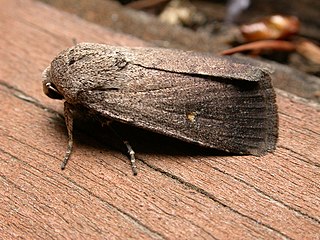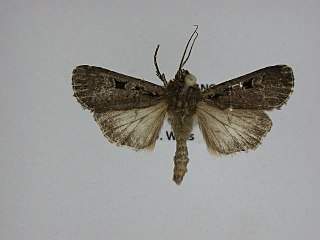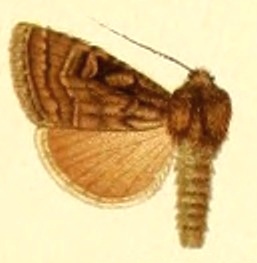
The Noctuidae, commonly known as owlet moths, cutworms or armyworms, are a family of moths. They are considered the most controversial family in the superfamily Noctuoidea because many of the clades are constantly changing, along with the other families of the Noctuoidea. It was considered the largest family in Lepidoptera for a long time, but after regrouping Lymantriinae, Catocalinae and Calpinae within the family Erebidae, the latter holds this title now. Currently, Noctuidae is the second largest family in Noctuoidea, with about 1,089 genera and 11,772 species. However, this classification is still contingent, as more changes continue to appear between Noctuidae and Erebidae.

Xestia is a genus of noctuid moths. They are the type genus of the tribe Xestiini in subfamily Noctuinae, though some authors merge this tribe with the Noctuini. Species in this genus are commonly known as "clays", "darts" or "rustics", but such names are commonplace among Noctuidae. Xestia moths have a wide distribution, though they most prominently occur in the Holarctic.

Eugraphe is a genus of noctuid moths. They belong to the tribe Xestiini of the typical noctuid subfamily Noctuinae, though some do not separate this tribe and include the genus in the Noctuini. It is closely related to Anagnorisma, Coenophila and Eugnorisma, and as it seems most closely to the first of these. The geographic range is Palearctic, north of the Alpides but including the Caucasus, and between the Arctic and the arid lands of Central Asia.

Proteuxoa is a genus of moths of the family Noctuidae. The genus was erected by George Hampson in 1903.

Agrotis fatidica is a moth of the family Noctuidae. It is found in Southern and Central Europe, east through Russia to Mongolia, China and Tibet.

Euxoa tessellata, the tessellate dart or striped cutworm is a moth of the family Noctuidae. It is the most widespread Euxoa-species in North America. It is found from Newfoundland to Alaska, south in the west to California, Arizona, New Mexico, south in the east to Florida. It seems to be absent from Texas and adjacent eastern states.

Euxoa adumbrata, the sordid dart, is a moth of the family Noctuidae. The species was first described by Eduard Friedrich Eversmann in 1842. In North America it is found across northern Canada from Quebec to western Alaska, south to the northern parts of the United States, and in the mountains to Colorado. It is also found in Greenland, the coastal areas of Scandinavia and the Ural. It was recently recorded from Denmark, although this includes Euxoa lidia, which some authors regard to be a valid species.

Goniographa is a genus of noctuid moths. They belong to the tribe Xestiini of the typical noctuid subfamily Noctuinae, though some do not separate this tribe and include the genus in the Noctuini.

Goniographa marcida is a moth of the family Noctuidae. It is found endemic to the Kopet-Dagh mountain system in Turkmenistan and Iran.
Goniographa gyulaipeteri is a moth of the family Noctuidae. It is widely distributed in the western Tien-Shan Mountains, in the Hissar and Alai Mountains, in the western Pamirs and also in north-eastern Afghanistan (Badakhshan).
Goniographa decussa is a moth of the family Noctuidae. It is found in the western Tien-Shan Mountains.
Goniographa shchetkini is a moth of the family Noctuidae. It is only known from a single location near the Liangar Glacier.

Goniographa funkei is a moth of the family Noctuidae. It is found in the western Tien-Shan Mountains, the Hissar Mountains and the western parts of the Pamir massif.
Goniographa metafunkei is a moth of the family Noctuidae. It has a strictly limited distribution in the western part of the Tien-Shan Mountains and the Alai Mountains.
Goniographa naumanni is a moth of the family Noctuidae. It is confined to the Hissar Mountains, the western Pamirs and the north-eastern territories of Afghanistan.
Xestia ornata is a moth of the family Noctuidae. It is found from the northern Tien-Shan Mountains through the Pamirs and Hissar-Darwaz system to eastern Afghanistan (Nuristan).
Xestia hypographa is a moth of the family Noctuidae. It is only known from the north-western part of the Tien-Shan Mountains.
Proteuxoa goniographa is a moth of the family Noctuidae. It is found in Queensland.

The Erebidae are a family of moths in the superfamily Noctuoidea. The family is among the largest families of moths by species count and contains a wide variety of well-known macromoth groups. The family includes the underwings (Catocala); litter moths (Herminiinae); tiger, lichen, and wasp moths (Arctiinae); tussock moths (Lymantriinae), including the arctic woolly bear moth ; piercing moths ; micronoctuoid moths (Micronoctuini); snout moths (Hypeninae); and zales, though many of these common names can also refer to moths outside the Erebidae. Some of the erebid moths are called owlets.

Eugraphe sigma is a moth of the family Noctuidae. It is found from most of Europe to the Ural, Siberia, Transcaucasia, Armenia and Korea.











